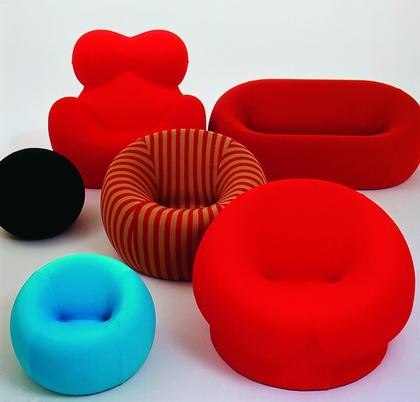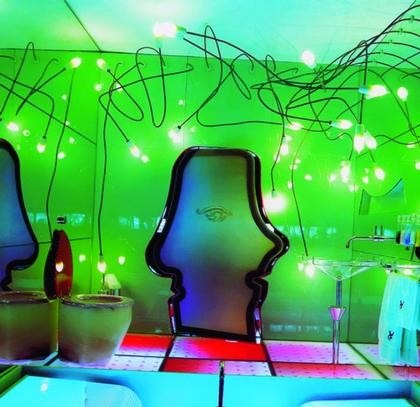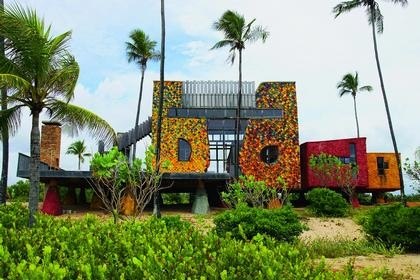|
Gaetano Pesce is one of participants of an exposition of Russian pavilion of XI Venetian architectural biennial
Gaetano Pesce is an Italian architect, artist, designer and the man of the world, living in New York City since 1980. His first major design invention might be his best work – the famous “Up” chair, which was presented at the 1969 Milan Furniture Show. The organic shape molded out of polyurethane foam evokes beautiful curves of a female body. There is a foam sphere attached to the chair with a rope provoking an image of a prisoner and a strong political statement about freedom. Yet, the same chair can be taken neutrally and playfully – you kick the ball and it comes back. How many ideas can one express in a chair? Well, there is one more and it is quite radical – the packaging. The “Up” chair could be compressed almost flat since it is 80% air. The package is so light and small that anyone can pick it up at a store and bring home. Then the chair magically appears out of nowhere – great modern spectacle in the comfort of consumer’s own home. There is another point – the chair is really comfortable to sit on! Over the years, Pesce created many thousands of innovative products for leading manufacturing brands and prestigious museum collections.
Pesce is intrigued by modern day Moscow and after ten or so trips there, still finds plenty of room for discoveries. He compares this dynamic metropolis on many levels to New York or Tokyo. In 2002 at the Milan Furniture Fair, the designer created his vision for “Moscow Room” project with resin furniture, lamps and pillows shaped as Russian Orthodox church domes, cut out profiles of Stalin and Putin, a bedspread with the map of Moscow and the glass floor painted with tiny red hummers and sickles. In 2007, he was invited to St. Petersburg by AD Magazine to have a retrospective of his work. To his surprise, he is much more popular in Russia than in the US and now is involved in a number of fascinating projects that could happen only in Russia. We comfortably sat down in his design studio on Broadway, surrounded by brightly colored vases, sofas, chairs, architectural models, paintings, books and many inspiring and innovative creature-looking things that make this room – one of the most inspiring places in the world.
– I heard there is a fantastic apartment that you designed in Moscow. The rumor has it that there is a river running between rooms and kids ride up and down the stream in a real boat! Is it for real?
– Just rumors! I designed this wonderful apartment just like you are describing for a private client in Moscow and I think it is a very nice project. But then the wife of the client asked me to do a silver sofa. I said – ok, I’ll paint it in silver. That wasn’t what she wanted. She wanted the sofa made of real silver, weighting 2 tons, maybe more. I don’t do that so the project stopped right there.
– Or maybe the project was built and you just don’t know about it. Do you have any other projects in Russia?
– Just today, I finished a project for a developer in St. Petersburg. He wants to build a little housing village. He saw my project in Brazil where I designed a small recreation center with a gym, a spa and a play area for children. I also suggested including three green houses in the shape of Russian church domes. I’m critical of architecture that doesn’t have any identity so I searched for something that has local character. I started with the idea of a cupola and talking with the client, he told me that the origin of the cupola shape is the flame. So my green houses moved from domes to the flame. I imagine them to be made of beautiful multicolored glass. I’m going to Russia to present this project.
– How many times have you been to Russia?
– At least ten times. The first time that I went there was in 1958 to experience communism. I traveled there for three weeks in many different cities and everybody looked the same to me. So I started to think that there is international style in architecture and there is international style in politics. I didn’t agree that in China, Russia or Europe everything had to be the same. I started to think that architecture should be like people. We are all different and our architecture should be different. The climate, the culture, the context and so forth should provoke a different kind of architecture. I think Moscow as a place is exploding with curiosity. There is so much interest in doing something unexpected. I like working there. I think architecture is rare, meaning what surrounds us everywhere – is not architecture, but mere buildings. Architecture is something that happens once in 100 years. Architecture is innovation. It is the use of new materials. Falling Waters by Frank Lloyd Wright – is architecture. Brunelleschi’s Dome is innovative in its expression, structure, materials. But if you copy his dome today – that is not architecture – just an ordinary building.
– Is Pesce your real name?
– Yes.
– It means fish in Italian, right? Is it symbolic for you?
– Yes. You know, in some cultures fish has a particular meaning. In China, it is identified with good health. Chinese have fish tanks at their homes so any misfortune would strike the fish first and protect the occupants of the house. And if you join five Greek words which mean “Jesus Christ the Son of God, the Savior”, they will make the word, that is, fish. I did one marina project in front of a small town in Italy and I made it in the shape of a fish. Not because of my name, but to celebrate the symbolic meaning of it. Also I believe that today we should go back to figurative architecture, not abstract. If you look at most contemporary buildings, you would not know what is inside. I believe that in the future, we will use symbols to distinguish meanings of different buildings.
– More and more architects are using what Charles Jenks calls enigmatic signifier. In other words, buildings are identified with a number of forms and shapes. The best examples are buildings by Le Corbusier or Frank Gehry. Gehry’s Guggenheim is reminiscent of a mermaid, a swan, an artichoke, a sailboat and of course, a whale or fish.
– Interesting. I thought Gehry was very abstract. Let me show you something (Pesce walks to his desk and brings a few photographs back) – look at this house interior. When you look out – you see the profile of a face (the face is formed by a contrast between solid wall and a large window frame with another small round window, representing an eye – V.B.). Also cabinetry evokes human bodies and faces. This is my own house in Brazil.
– Do you think this humanizes buildings?
– This is a way to make a connection with people, because people do not relate to abstraction. The problem with abstraction is that it takes you away from local context and it strips the identity from a particular place. You see, a church looks like an apartment building, an apartment building looks like a factory and so on. It is confusing. Objects inside declare the use of buildings – a bed, a couch, a desk, a bathtub – but architecture no longer tries to make such distinction. There is the identity crisis.
– You went to Architecture School in Venice. Did you meet anyone particularly influential there?
– My school was the best in Italy. The professors there were very progressive architects and historians, especially Carlo Scarpa and Bruno Zevi. There were 75 students and 30 or 35 professors so we were all very close.
– There are so many beautiful things from fashion, film, industrial design, furniture, cars and so on that are made in Italy. What makes Italian design so special?
– Italian design is a consequence of Italian Art. In the 20th century, Futurism affected every medium of art – painting, sculpture, theater, poetry, music, architecture. This movement was originated by a poet Filippo Marinetti and it celebrated speed, energy, industry, production, the machine and technological triumph over nature. The industry became the center of life. Creativity played a very important role in manufacturing and the designers, not artists came at the forefront of technology and mass production. High-level design is common place in Italy. It is everywhere – on every street.
– Were you active in such movements as Alchemia and Memphis?
– No, I was active in Radical Design. I also created an experimental company for radical design, called Braccio di Ferro, meaning arm of iron. I never collaborated with Alchemia and Memphis because both of them were postmodern. I see Postmodernism as a very reactionary expression.
– What is the difference between what you did and postmodern?
– In Braccio di Ferro we searched for new progressive expression, where as Alchemia and Memphis simply revived and repeated styles from the 1930’s. Let me show you an example (Pesce goes back to his desk and finds a few photographs of his installation, the Golgotha from 1970). This scene was not the revival from the past. Everything here is very modern to the time it was designed – the chairs, the table, the costumes and so on. The idea here is taken from history but not in terms of forms and style, but its content. It was a connection between design, history and religion. Before that, design was just a decorative and applied expression so here is another dimension for design.
– What is good design for you?
– I believe that good design is a commentary on everyday life. It is not simply the expression related to forms and styles but to what is happening in everyday life. It is a commentary on the real world.
– Why after finishing architecture school, you designed chairs and not buildings?
– To realize a chair you don’t need a lot of money. All you need is to find a company that would be interested in realizing your design. In architecture, it is much harder to find someone who would take a risk in realizing your idea. Developers or other clients are not going to spend money on innovation. They would not pay for the building to be blue in the morning and red in the evening, following the change of temperature.
– Is that what you want to do?
– Sure, or for example, Elastic House that I tried to build in Brazil – I used rubber and resin in wall construction and then one day it collapsed, why – because it was very experimental.
– What collapsed?
– It was an experimental house. I was experimenting with a rubber wall – trying to test its constructability and one day it collapsed.
– Did you rebuild it?
– No, there was no money to do the second test. That’s why I’m telling you that architecture has limits to how much it can afford experimentation. But in the future, I’m sure, architecture will be more like our own body – not rigid and concrete, but much more organic and reacting to the atmosphere. You know, rubber has a terrible smell, so I used another plant, juniper, which smells very good. I mixed the two together to produce a good atmosphere. That is the kind of architecture I want to do – a place that you would want to smell, touch and see in a different way. The technology already allows us to experiment in that direction.
– Why did you leave Italy?
– Maybe for the same reason you left Ukraine. You know your own place well and you need to learn more about the world. I lived in Venice, London, Helsinki, Paris and now I’m in New York.
– When you came to New York, for a while, you were teaching at Cooper Union, right?
– Yes, I was teaching students to invent elastic architecture. It was very different from other professors there. For example, Eisenman was exploring very rigid, dogmatic, kind of Theo van Doesburg geometry. I asked students to design elastic skyscrapers in Manhattan. I remember that the best projects were done by female students. They understand elasticity much better. We experimented a lot with mixing rubber, resin and crystals. One girl created a building that would show various deformations. It was a small library. When it was full of people, it would bend down and so forth. So the building was very informative of what is going on inside. I think contemporary buildings should express new technology in many different ways.
– How do you work?
– Just like I always worked. I come up with an idea and look for a client to realize it. Right now in this office, we have three people – two assistants and myself. Next door, there is a production shop where one artist works. If we go ahead with this Russian project in St. Petersburg, I will collaborate with a local architect there.
– Is resin your favorite material?
– I think each time should have its own material. There was time when architecture was realized in wood, brick or marble. Today we are mostly using materials that were used in the past – metal, concrete and glass. I try to use new materials. I discovered rubber after graduating from school. I contacted various chemical companies to let me see how they use rubber, resin, silicon, etc. in their laboratories and production. I’m fascinated with this fantastic material. Even today, many students are not aware of it. Architecture schools should educate about new materials and new technology.
– After designing so many products, do you still have a dream of designing something for the first time?
– There is always a place for innovation and discovery, so you always find something for the first time. For example, right now I’m working on table design. Usually it is rectangular. But I’m not sure that is how it should be. For me a question mark is very important. So this table is shaped as a question mark and around the question mark, I have small individual stations – one per person. This way it is much more personal and not generic. Each station has its own shape and color. In our time, we have a lot of questions and very few answers. I have a question mark shape in many of my projects, not an exclamation mark.
None
None
None
None
None
|




